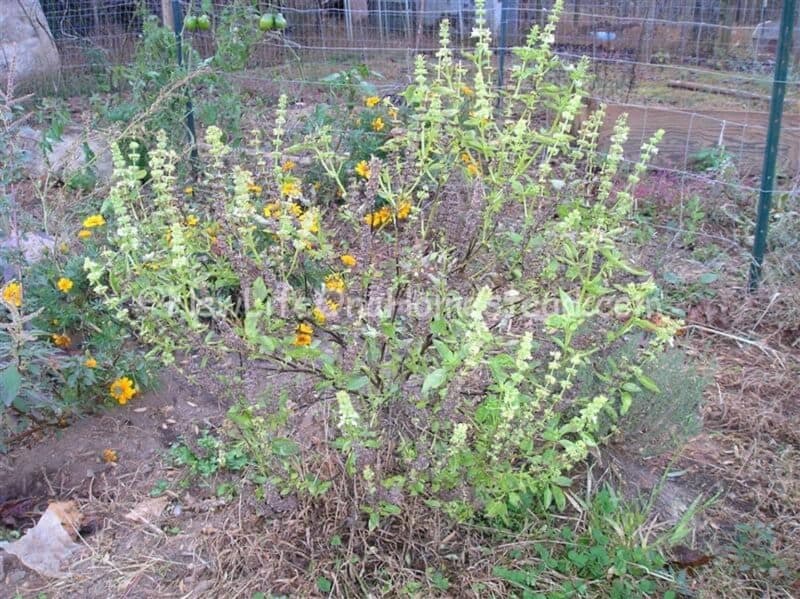
By this time of year, Basil plants are pretty much finished producing their flavorful leaves and have gone to seed just before dying back for the winter. My poor basil. He’s looking awfully scraggly:
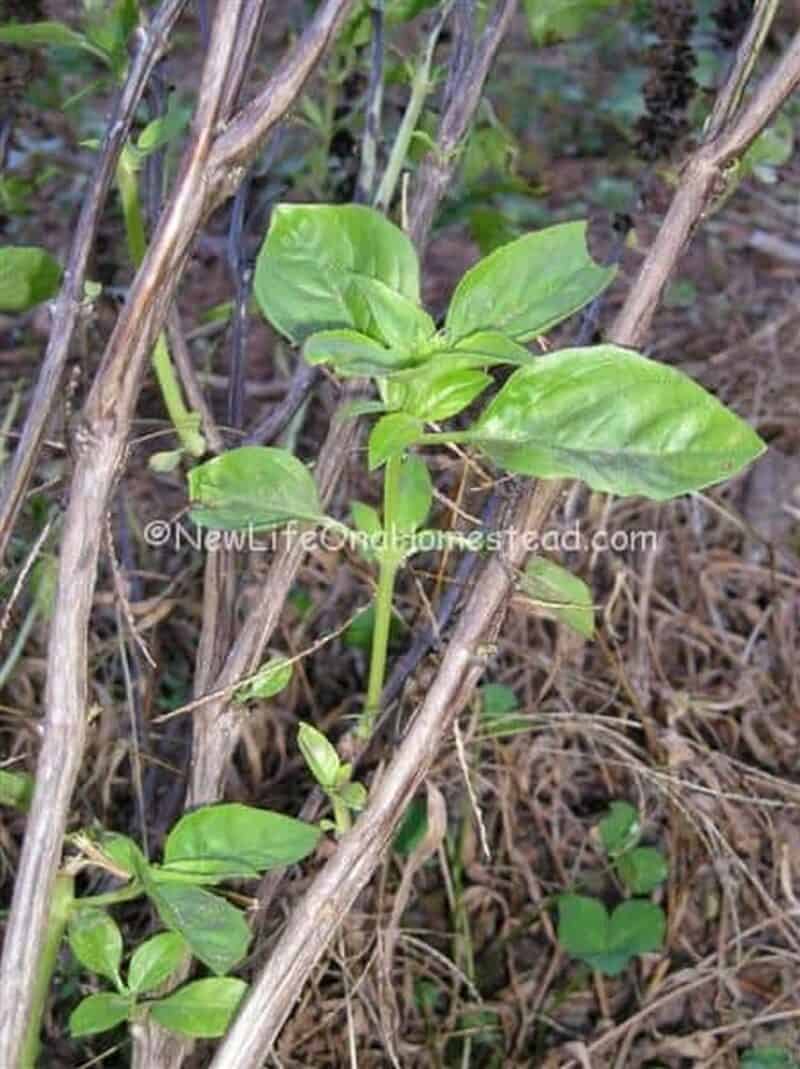
But don’t uproot them just yet! If you look closely enough, I’m betting you’ll find a few good looking clusters still trying to grow. Did you know that you can actually use these to propagate a whole new basil plant?
Why Grow Basil From Cuttings?
Basil is a popular herb that is used in a variety of dishes, from pesto to caprese salad. You can grow it in just about all growing zones and rooted basil cuttings develop quickly.
While it is relatively easy to grow basil from seed, some gardeners prefer to take cuttings from an existing plant.
There are several reasons for this.
First of all, cuttings are a faster and more reliable method of propagation than seeds. Basil seeds can be difficult to germinate, and even if they do sprout, the basil seedlings are often weak and delicate.
By contrast, cuttings will almost always root successfully, and the resulting plants are typically strong and vigorous.
In addition, taking cuttings allows you to preserve the genetics of your favorite basil plants. If you’re growing a particularly flavorful or disease-resistant variety, taking cuttings ensures that your future plants will have the same characteristics.
Finally, starting with cuttings gives you a head start on the growing season. Since cuttings are taken from mature plants, they will already have several leaves and may even be blooming.
This means that you can harvest basil earlier than if you had started from seed. For all these reasons, many gardeners choose to grow basil from cuttings rather than seeds.
Other Methods of Propagating Basil
While many gardeners choose to propagate basil by taking cuttings, there are a few other methods that can also be used. One option is to sow basil seeds directly into the ground in late spring or early summer.
Another option is to purchase a young plant from a nursery and transplant it into your garden. Whichever method you choose, be sure to give the plant plenty of sunlight and water it regularly; basil thrives in warm, moist conditions.
Materials Needed to Grow Basil from Stem Cuttings
To grow basil from cuttings, you will need the following materials: a clean, sharp knife or gardening shears; a jar of water; small pot or container filled with moistened potting mix; and a basil plant.
You may also want to invest in some rooting hormone. This is optional. I’ll discuss this component in more detail below but keep that in the back of your mind for now.
Where to Get the Basil to Take Your Cuttings
A trip to the grocery store is all it takes to get started with basil cuttings. Look for a healthy plant with plenty of lush, green leaves. This will allow you to root basil that is healthy and strong. Avoid any plants that are wilted or have brown spots.
You can also get basil from friends or neighbors who have basil plants. You can even order plants online or from your local nursery.
Of course, if you already have your own basil plants, then sourcing new ones shouldn’t be a problem!
Steps to Grow Basil from Cuttings
Taking cuttings from plants and rooting them is a fantastic way to speed up the process of growing a new plant. Here’s how to grow basil from cuttings…
Start With Healthy Basil
To ensure success, it is important to start with healthy basil plants. Look for plants that are full and lush, with no signs of pests or diseases.
A healthy basil plant has lush, green leaves and strong basil stems. The leaves are glossy and free from brown spots or other damage.
Basil plants should be trimmed regularly to promote new growth and prevent the plant from becoming overgrown so taking a cutting from the plant can actually serve two purposes.
Snip Off the Top of a Stem (Prune Your Basil)
First, snip off the top of a stem of basil from a mother plant:
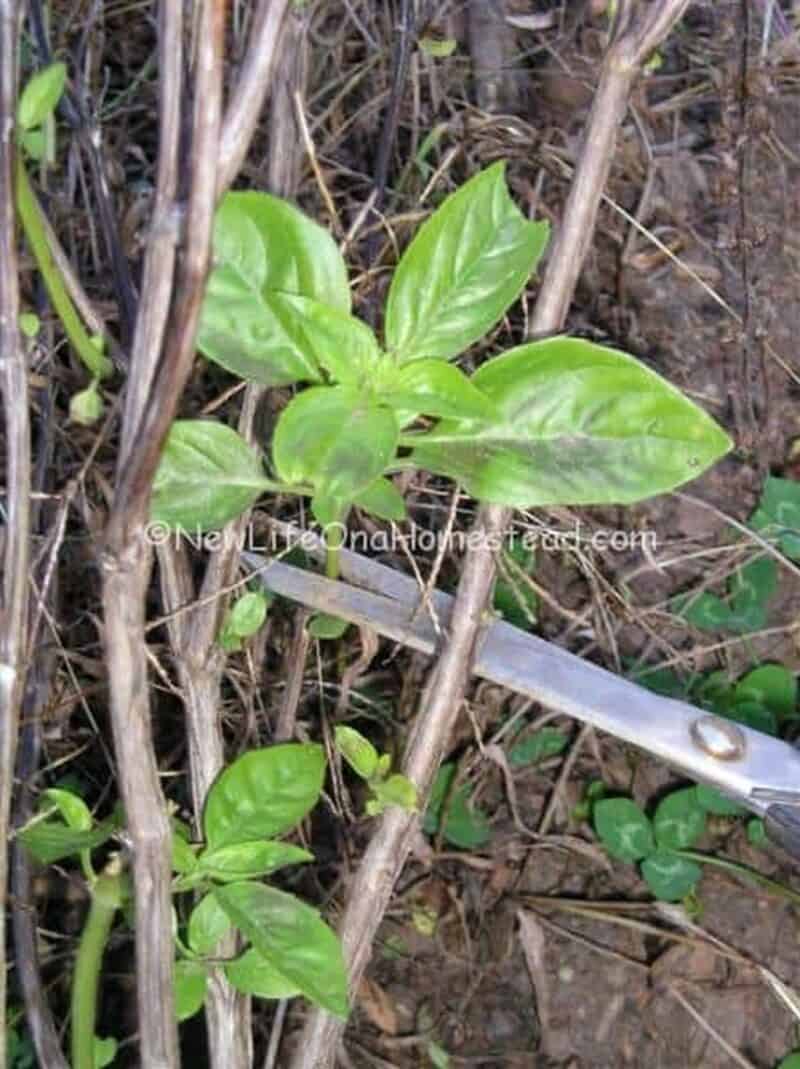
Make sure you cut it below a leaf node (where a new little leaf is growing out of the elbow of a larger leaf). The cutting should be about four to six inches long and you should try to take it at an angle. You can cut just one or multiple cuttings to root your basil in water:
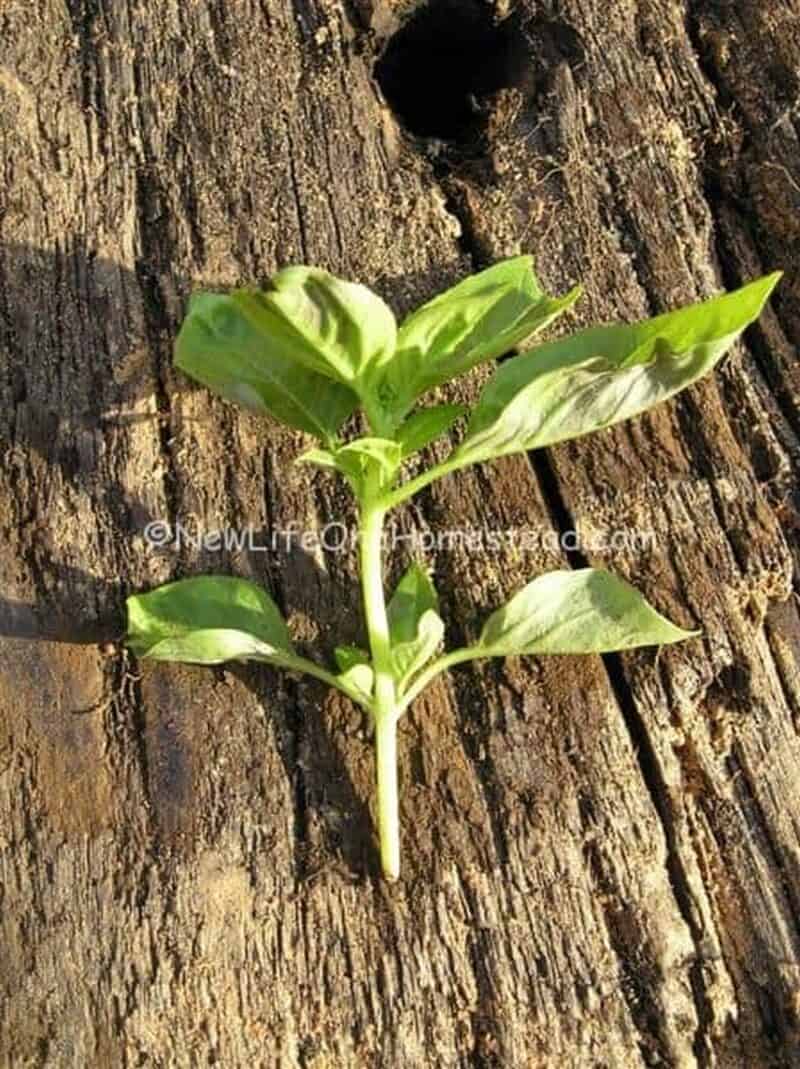
Prepare the Cutting
Before putting the basil in water, you need to prepare the cuttings. Pinch off or cut the bottom two largest leaves. Trim the bottom of the stem, chopping about a quarter of an inch between the lower leaf node.
Pinch off or cut the bottom two largest leaves:
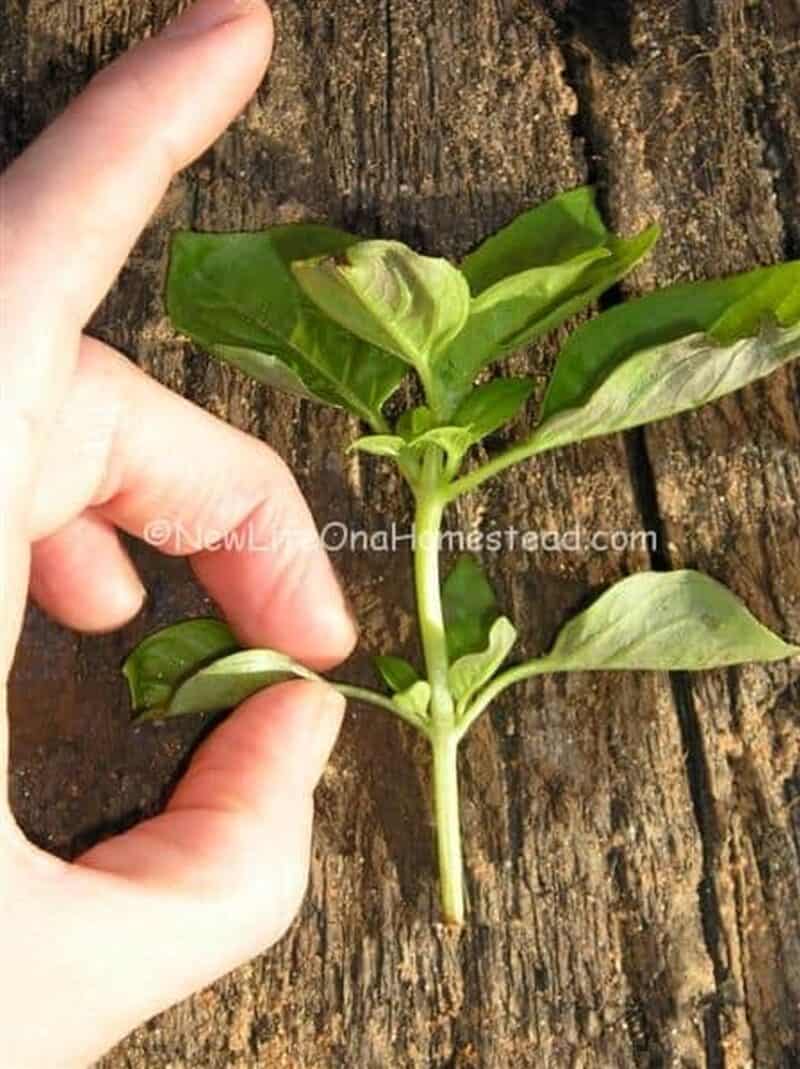
It’ll look like this after you’ve removed the lower leaves:
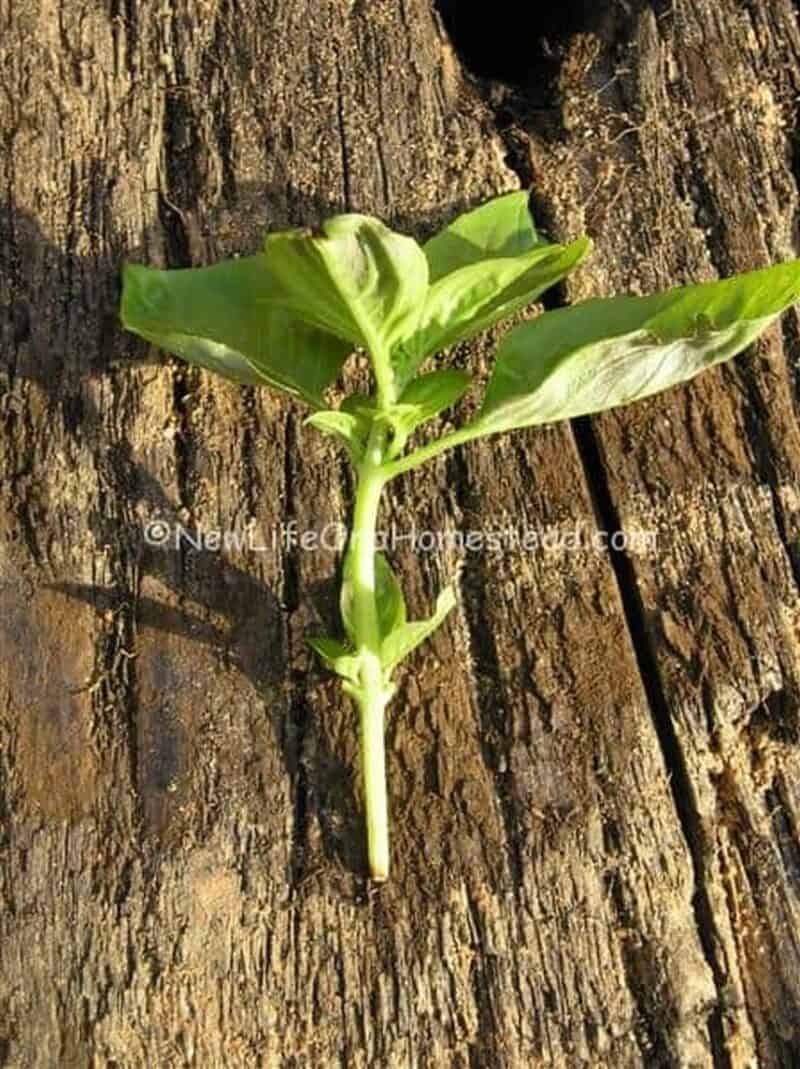
Put the Basil in Water
Then place the cutting in a jar of water or a glass of water for about two weeks. That’s it!
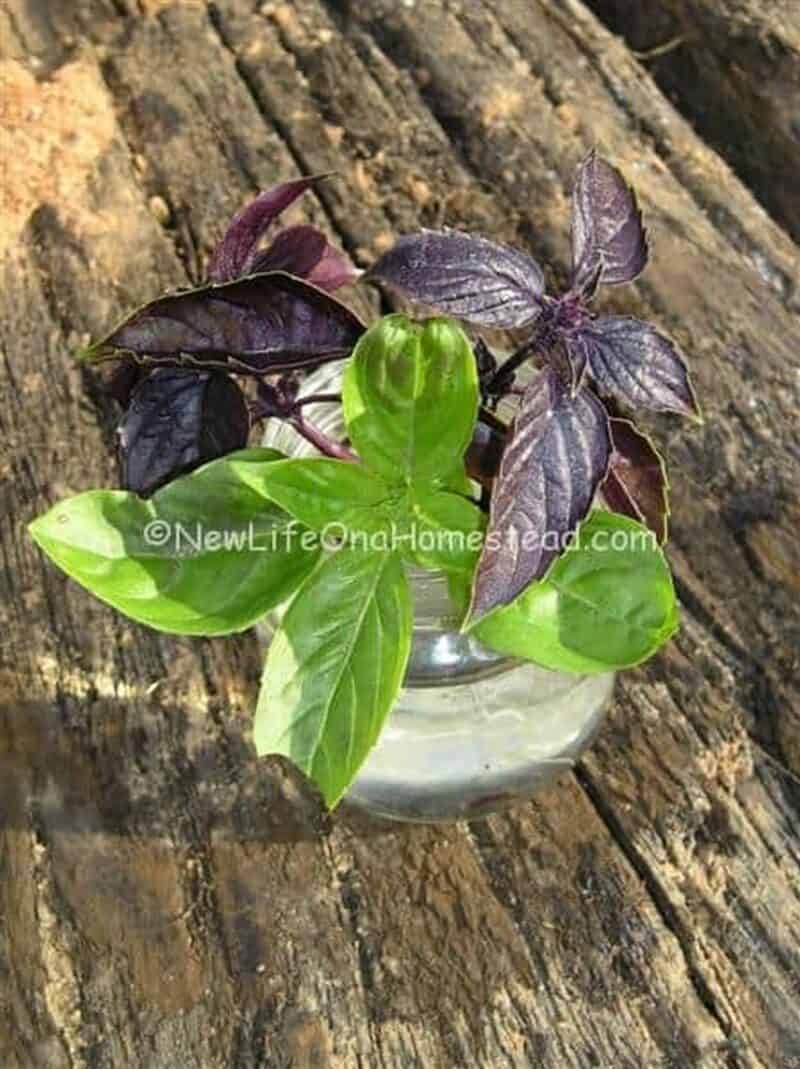
Keep the water fresh, and you’ll have a nice set of roots growing in no time!
A few notes on the water. First, you should use dechlorinated tap water. Most tap water has some chlorine or other chemicals in it, but you can air off the chemicals by boiling it for 20 minutes and then cooling it to room temperature.
You can place multiple basil cuttings in each jar of water, but as the roots develop, you may need to separate them out so that they don’t get tangled and intertwined. If they do, you’ll ultimately have to plant them together, since separating them can be a challenge.
Make sure the cutting stems are fully in the water and totally submerged – but that the leaves are above the water line. The rest of the plant can rest on the rim of the jar.
Change the Water Often
Change out the water often for your cuttings. Dechlorinate the water when you do, again, boiling the water and bringing it to room temperature first.
While changing out the water won’t necessarily help your basil cuttings grow faster, it will help to prevent the growth of bacteria and keep your cuttings as healthy as possible.
Put the Jar in the Sun
Put your jar in an indoor location where it will receive direct morning sunlight and indirect afternoon sunlight. Although mature basil prefers lots of sunlight, you need to be careful about putting your fragile cuttings in too much direct sunlight as they are still too immature to handle the heat.
Some people recommend putting a plastic bag or plastic wrap over your planter or jar, but I try to avoid this unless my plants aren’t getting enough heat.
The clear glass should be enough to help your plant get started and if it’s not, grow lights may be able to give your plants some heat and light.
However, if you’re growing your basil plants in indirect light, as is recommended, and the plant propagation requires more humidity, the plastic wrap method can work well. Just be sure to remove the wrap so algae or rot doesn’t occur.
You can put your basil cuttings on a windowsill – just be mindful of how much sun the jar receives.
Wait for Roots
After about two weeks have passed, you should have roots poking out of the bottom of the basil cutting. Give it another two weeks and wait until the cuttings’ roots are about two to three inches long.
Transplant to Potting Soil Mix
Once the cutting has formed roots, it’s ready to be transplanted into a potting mix. Basil prefers well-drained soil and full sun, so choose a spot in your garden or on your windowsill that meets those requirements.
A good potting mix should be loose and well-draining, as basil does not like to sit in wet soil. It should also contain some organic matter, such as compost, perlite, or peat moss, which will help the cutting to retain moisture.
To transplant the cutting, dig a hole that is slightly larger than the root ball and water the plant thoroughly before placing it in the hole. Gently firm the soil around the plant and water again.
Care for the Cuttings in the Potting Mix
After you have transplanted your basil cuttings into the potting mix, it is important to water them regularly and fertilize them every two weeks.
Watering will help keep the soil moist and prevent the roots from drying out. Fertilizing will provide the plants with the nutrients they need to grow. When watering, be sure to use a spray bottle so that the leaves are not wetted.
Wet leaves can encourage fungal growth. Additionally, be sure to water in the morning so that the leaves have time to dry before nightfall. Nighttime watering can encourage fungal growth and more diseases problems.
Also, make sure that you keep an eye on the size of your potting mix. If it starts to dry out, add more water.
Finally, when fertilizing, use a fertilizer that is high in nitrogen. This will promote leaf growth. Nitrogen is especially important for basil because it is a fast-growing plant.
Transplant to the Garden
Basil plants should be transplanted to the garden after all danger of frost has passed and the soil has warmed. The best time to transplant is late spring or early summer.
Once all danger of frost has passed, after the last frost, transplant the basil plants into the garden. Choose a sunny spot with well-drained soil. Space the plants 12-18 inches apart.
When transplanting basil, the first step is to gently remove it from the pot. Be careful not to damage the roots as you do so.
Next, dig a hole in your garden that is slightly larger than the pot. Gently loosen the roots and place the plant in the hole. Once it’s in place, backfill the hole and water thoroughly.
Water regularly and fertilize every 2-3 weeks. Pinch back the tips of the plant to encourage bushiness. Basil will bloom in midsummer; pinch off the flowers to keep the plant from going to seed.
Harvest basil leaves throughout the summer as needed. Cut back any time the plant begins to look leggy or overgrown.
With a little care, your basil plants will provide you with an abundance of fresh flavor all summer long!
Should I Add Rooting Hormone When Growing Basil from Cuttings?
When growing basil from cuttings, there are a few things to consider. One is whether or not to add rooting hormone. Rooting hormone can certainly be helpful, as it can promote root growth and help the cutting to establish itself more quickly.
Rooting hormone powder is a substance that helps to encourage root growth in plants. It is typically used when propagation, or the process of growing new plants from cuttings, is desired. Rooting hormone speeds up the rooting process and makes it more likely that the cutting will take root successfully.
There are synthetic rooting hormones available, but many gardeners prefer to use natural substances like aloe vera gel or willow water. When using a synthetic rooting hormone, it is important to follow the instructions carefully, as too much of the substance can damage the plant.
However, it is not strictly necessary, and many gardeners have success without using it.
To use rooting hormone, first sterilize a sharp knife or pair of scissors and a small pot with drainage holes. Then, take a cutting from a healthy basil plant. Next, remove the bottom leaves from the cutting, and dip the exposed stem into the rooting hormone.
Ultimately, the decision of whether or not to use rooting hormone is up to the gardener.
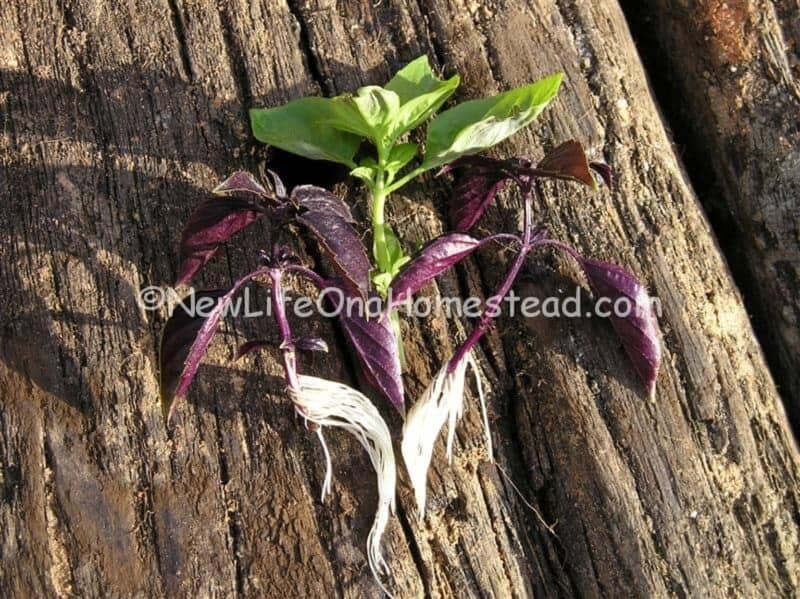
Final Thoughts
My mother-in-law had some purple basil growing, and since I didn’t have any seeds for purple basil, I asked her if I could pinch off a couple of hers. Here they are a little over 2 weeks after I cut them and put them in water:
Notice the lovely roots! They’re already ready to be potted up. I’ll probably keep them in the greenhouse, or on my kitchen windowsill to save until Spring comes and I can plant them outside.
Isn’t it great to know that you don’t have to start new plants from seed every time you want one?! I just love shortcuts like this – and I love fresh basil in my herb garden to use in all my favorite recipes! Tomato sauces, pasta, and basil pizza, anyone?
updated 07/26/2022 by Rebekah Pierce

A city girl learning to homestead on an acre of land in the country. Wife and homeschooling mother of four. Enjoying life, and everything that has to do with self sufficient living.

I have a friend who propagates nearly anything this way. Roses, herbs, trees… she’s amazing with this. She just takes a cutting and puts it in pot with soil and keeps it moist. I haven’t had the luck she’s had!
I wonder if this could be done with store-bought herbs.
Christine,
Absolutely!! You can do this with home grown or storebought plants, doesn’t make a difference 🙂
Yes, this is how I got started with mine I bought a basil plant from Publix, then watched several different videos to get a well rounded idea of how to.
I have tried doing this so many times and never get roots. The end of the stem just rots. I always leave room so the ends don’t hit the bottom of the glass and leave t in a wndow for the light. What am I doing wrong? I do exactly what you posted. I now buy a BIG basile plant and use it all winter and do this with Parsley also. I have good luck doing that. thanks
Hi Joanne,
Hmmmm… This was my very first time attempting this with Basil, and it took off with no trouble at all. Are you changing the water frequently (every other day)? And did you make sure to cut beneath a leafnode, and is the leafnode submerged? Those are the first questions that come to mind. I wonder if city water vs. well water is an issue?? Perhaps, if you are using treated city water, there are too many additives to hinder the growth of a plant. I’d be curious to hear what type of water you are using!
My dad has been trying to do this for ages! After finally having some success, he realized the reason was a little worm beneath one of the leaves who was helping fertilize his water. So now he’s been trying this with all types of plants, and he always throws in a little llama poop into the mix!
Megan,
Like in Joanne’s case… I wonder what type of water your dad is using? Do you know if he has city or well water? I’m curious to know if that makes a difference in how well this method works!
I wish I had read this a couple of hours ago, I just cut my basil down and made basil oil out of it!
Oh no, Twisted Cinderella! LOL! Well, at least you made good use of it and didn’t just toss it 😉
NICE! This is great to know! Thanks Kendra!
I didn’t know you could do that ,good thing I plan on growing basil.I’ll keep this in mind thankyou!